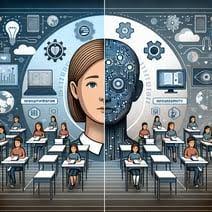
Artificial Intelligence (AI) has become an integral part of the education landscape, transforming how educators and students interact with learning materials. AI in education offers various opportunities, such as personalized learning experiences and administrative efficiencies, while also posing challenges related to academic integrity and equity. Embracing these tools requires careful consideration of these factors to maximize benefits and minimize drawbacks in an academic setting.
The introduction of AI in classrooms can vastly enhance both teaching and learning processes. For example, AI tools like ChatGPT can assist in grading, offer personalized feedback, and create adaptive learning paths tailored to individual students’ needs. This integration can help educators manage their workloads more efficiently and focus on fostering critical thinking and problem-solving skills among students. However, as highlighted in this NPR article, the rapid evolution of AI technologies also demands ongoing adjustments in educational practices and policies to maintain academic integrity and foster innovation.
While there are significant benefits to harnessing AI in education, it also raises concerns, particularly regarding the risk of students over-relying on AI-generated content, which might affect their critical thinking development. Discussions, such as those detailed in this report by KQED, reflect the diverse perspectives of educators and students. Some view AI as a valuable tool that can make education more engaging and inclusive, while others fear it could undermine essential academic skills if not integrated thoughtfully.
Opportunities of AI in the Classroom
The integration of artificial intelligence (AI) in educational environments is opening new avenues for personalized and effective learning experiences. According to research and expert opinions, AI tools like ChatGPT are enhancing classroom interactions by offering personalized assistance to students, thereby allowing teachers more time to focus on creative and complex pedagogical tasks. This can lead to more dynamic learning environments where instructors can cater to the specific needs of students at different learning paces.
AI’s capability to analyze large sets of data rapidly means it can also serve as an efficient tool in assessing student performance and understanding individual learning patterns. As described in various educational experiments, AI algorithms can track student progress in real-time, identify areas where students might be struggling, and subsequently suggest personalized resources and learning paths. This not only facilitates improved learning outcomes but also ensures a more inclusive educational landscape where every student has the opportunity to succeed.
